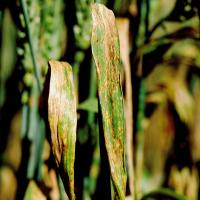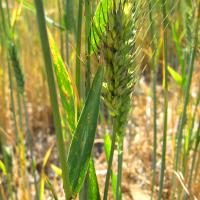Septoria nodorum and yellow spot often occur together and are generally impossible to distinguish by the naked eye. Septoria tritici is considered rare in Western Australia. The only time when it is important to distinguish septoria nodorum from yellow spot is infections late in the season that could lead to glume blotch if there is septoria nodorum moving up the canopy. Otherwise both diseases respond similarly to registered fungicides.
Diagnosing septoria nodorum of wheat
A stubble borne foliar fungal disease caused by Parastagonospora nodorum (previously Phaeosphaeria nodorum, synonyms Stagonospora nodorum; Septoria nodorum). Occurring commonly throughout the Western Australian wheatbelt particularly in high rainfall areas and can reduce grain yield and cause shrivelled grain.
What to look for
- Blotched, yellowing and dead leaves evenly distributed across paddock.
Paddock
- Tan-brown oval or irregular shaped leaf blotches with narrow yellow margins. Tiny brown fruiting bodies can occasionally be seen in lesions.
- Blotches become grey as they enlarge.
- Badly affected leaves die back from tip as blotches converge.
- Lower leaves affected on young plants.
- Disease can spread to glumes and stems and heavy infection causes blotching across the entire grain head with shrivelled grain at harvest.
Plant
What else could it be
| Condition | Similarities | Differences |
|---|---|---|
| Diagnosing septoria tritici of wheat | Tan leaf blotches with yellow margins | However Septoria tritici has irregular, often interveinal, not oval lesions that contain small black fruiting bodies. Septoria tritici rarely attacks the head or glumes. |
| Diagnosing yellow spot of wheat | Tan leaf blotches with a yellow margin | However yellow spot blotches more often start as yellow rather than tan, fruiting bodies are not present in leaf lesions, and head and glumes are less affected. |
Where did it come from?

Wet or humid conditions
- Air borne spores from oversummering fungus in stubbles can infect crops over large areas.
- Secondary infection from splash dispersed secondary spores spreads through the crop.
- Disease is most damaging in warm, moist conditions especially those enabling leaves to remain wet for 6-12 hours.
Management strategies

Resistant varieties

Spraying foliar
- Generally an application of foliar fungicide to manage septoria diseases or yellow spot is more likely to be economic when:
- The crop has good yield potential
- There is a good chance of 100mm or more after flag leaf emergence.
- When applied at or around flag emergence (Z39) to protect the flag and flag-1 leaves, which contribute the most to filling grain.
- With septoria nodorum, it is important to control the disease if it is moving up the canopy in order to protect the the heads from glume blotch infection.
- Other treatment options:
- Reduce surface wheat stubble before seeding.
- Sow varieties with higher levels of resistance or rotate with a non-host crop such as barley.
- If disease is severe early, consider a foliar fungicide spray around first node (Z31), a second spray may be required around flag leaf emergence.
Economic and financial considerations
To assist in assessing the economic risk and financial costs associated with various treatment strategies go to MyEconomicTool
There may be other economic and financial implications that need to be considered when choosing a management option. These may include:
Pre-crop- Assess the risk of Septoria nodorum occurring.
- Understand the potential yield losses associated with infection.
- Assess the costs and benefits of taking preventative action.
- Compare the costs, benefits and risks of each management option against doing nothing.
- Consider risk and associated costs or savings of delaying treatment.
- Consider the potential risk of re-infection and costs of further treatment.
- Ignore all previous treatment costs in assessing current management options.
- Undertake a ‘what if’ scenario analysis to see what impact changing variables (e.g. grain price and seasonal conditions) have on the projected economic outcomes.
- Consider longer term consequences of not adequately treating Septoria nodorum.
View these economic considerations in more detail.
See also
Page last updated: Friday, 17 April 2015 - 2:22pm




